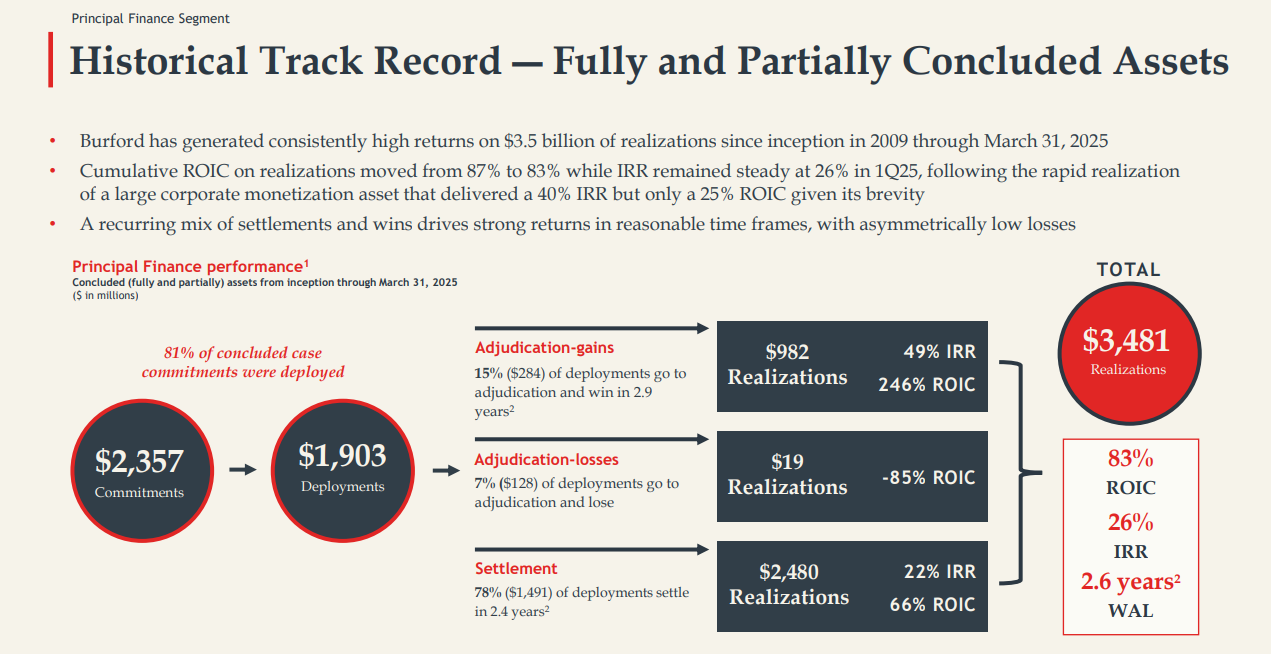Founded in 2009 by attorneys Christopher Bogart and Jonathan Molot, Burford Capital has emerged as a trailblazer in the niche field of legal finance. The duo, who collectively own approximately 10% of the company, continue to lead its operations, with Bogart serving as CEO and Molot as Chief Investment Officer .
Over the past 15 years, Burford has transformed from a $130 million fund into a global leader managing a $7.2 billion portfolio, setting the industry standard in litigation funding
The Business of Legal Finance
Burford essentially functions as an investment bank for lawsuits. When a company has a potentially valuable legal claim but doesn't want to tie up capital in lengthy litigation, Burford steps in to finance the case in exchange for a portion of any eventual recovery. Their clients include many of the world's largest corporations and law firms – they've received financing inquiries from 94 of the 100 largest US law firms.
The company addresses a fundamental misalignment in legal services: corporations want to pay lawyers based on outcomes, while law firms prefer steady hourly fees. By providing capital, Burford bridges this gap. They typically deploy at least $5 million per case, often much more, and have made over $11 billion in total commitments since inception.
Legal finance is particularly attractive because case outcomes are generally uncorrelated with broader economic conditions. Burford's concluded cases have delivered an average 87% return on invested capital with a 26% IRR, with the majority of cases settling rather than going to full trial.
Portfolio Structure and Economics
Burford divides its operations into two primary segments: Principal Finance and Asset Management.
Principal Finance involves Burford directly investing its own balance-sheet capital into litigation cases. Unlike traditional asset classes, litigation investments have unpredictable timelines and outcomes, typically taking an average of 2.6 years from funding to resolution, though durations can vary widely. This unpredictability often creates uneven or "lumpy" financial results.
Litigation investments typically follow a positively skewed return distribution, with outcomes clustered around either significant gains or complete losses. To date, 51 matters (13% of concluded cases by cost) have produced returns exceeding 200%, while approximately 14% resulted in losses.
The Asset Management segment allows Burford to leverage its litigation expertise by managing external capital through third-party investment funds. Burford earns management and performance fees, providing a steady revenue stream that complements the more volatile returns of Principal Finance. Currently, Burford manages approximately $2 billion of external capital across several private funds and joint ventures, significantly expanding its capital deployment capacity without burdening its balance sheet.
Together, these segments enable Burford to balance high-risk, high-reward direct investments with stable, fee-generating asset management activities, creating a diversified business model poised for sustained growth.
Competitive Advantage
Burford's edge comes from its proprietary data and underwriting expertise. With 15 years of case data, they've built sophisticated probabilistic models to assess litigation outcomes, allowing them to price risk more effectively than competitors.
Their approach blends quantitative analysis with legal expertise. The company employs 47 lawyers across seven jurisdictions who conduct detailed case assessments. Final investment decisions are made by a Commitments Committee, similar to an investment bank's deal committee.
For each potential investment, Burford receives privileged information from clients (a significant barrier to entry), conducts extensive due diligence, and creates tailored financing structures.
These aren't standardized financial products but complex arrangements where pricing varies based on case merits, duration risk, and collection likelihood.
The YPF Mega-Case
Burford's portfolio includes one outsized position: claims against Argentina related to the nationalization of energy company YPF.
These assets represent about 40% of Burford's capital provision assets, with $1.5 billion in fair value against just $76 million in deployed cost. In September 2023, the company won a $16.1 billion judgment, though Argentina has appealed.
This single case illustrates both the potential upside and concentration risk in Burford's model. While management believes it will "ultimately deliver a ten-figure recovery," the final outcome remains uncertain.
Business Evolution
As litigation finance has matured, Burford has expanded beyond simply financing legal fees. Today, corporations increasingly use Burford for "monetization" – accelerating the value of pending claims to improve liquidity and financial metrics. This shift has expanded their addressable market considerably.
Rather than using a fund structure like most alternative asset managers, Burford primarily invests from its own balance sheet, allowing it to compound returns internally. The company maintains modest leverage with $1.8 billion in debt against $2.4 billion in equity.
Burford's current strategy emphasizes deploying capital from its own balance sheet rather than raising more external funds.
The Future of Litigation Finance
While Burford's core legal finance business continues to grow, the company has signaled intentions to expand into adjacent areas of the legal ecosystem, potentially including law firm equity investments, alternative legal service providers, and legal technology .
Managing a $7.2 billion portfolio that has grown 50-fold since inception, Burford demonstrates both the scalability of its model and the vast untapped market opportunity.
According to Burford, their addressable market includes the $23 billion annual value of large US verdicts, $255 billion in pending international arbitration cases, and $819 billion in global legal fees.
Despite delivering substantial returns on capital, Burford faces challenges in communicating its complex business model to investors. As the legal finance industry continues to evolve, Burford's innovative approach positions it well to capitalize on emerging opportunities and redefine the intersection of law and finance.








Litigation finance is tough to understand.
The companies have good moats and a growing market (not much, but it's growing, especially in the US, which is the largest market).
I recommend you take a look at the write-up I did for one of Burford Capital's peers:
https://www.worldlyinvest.com/p/litigation-capital-management-lit